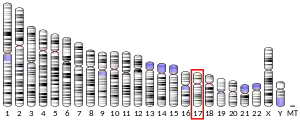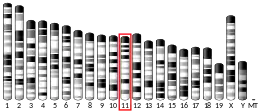C-C chemokine receptor type 7
C-C chemokine receptor type 7 is a protein that in humans is encoded by the CCR7 gene.[5] Two ligands have been identified for this receptor: the chemokines (C-C motif) ligand 19 (CCL19/ELC) and (C-C motif) ligand 21 (CCL21).[6]
CCR7 has also recently been designated CD197 (cluster of differentiation 197).
Function
The protein encoded by this gene is a member of the G protein-coupled receptor family. This receptor was identified as a gene induced by the Epstein-Barr virus (EBV), and is thought to be a mediator of EBV effects on B lymphocytes. This receptor is expressed in various lymphoid tissues and activates B and T lymphocytes. CCR7 has been shown to stimulate dendritic cell maturation. CCR7 is also involved in homing of T cells to various secondary lymphoid organs such as lymph nodes and the spleen as well as trafficking of T cells within the spleen.[7]
Activation of Dendritic cells in peripheral tissues induces CCR7 expression on the cell's surface, which recognize CCL19 and CCL21 produced in the Lymph node and increases dendritic cell expression of co-stimulation molecules (B7), and MHC class I or MHC class II.[8]
Clinical significance
CCR7 is expressed by various cancer cells, such as nonsmall lung cancer, gastric cancer and oesophageal cancer.[9][10][11] Expression of CCR7 by cancer cells is linked with metastasis to lymph nodes.[12]
References
- GRCh38: Ensembl release 89: ENSG00000126353 - Ensembl, May 2017
- GRCm38: Ensembl release 89: ENSMUSG00000037944 - Ensembl, May 2017
- "Human PubMed Reference:". National Center for Biotechnology Information, U.S. National Library of Medicine.
- "Mouse PubMed Reference:". National Center for Biotechnology Information, U.S. National Library of Medicine.
- Birkenbach M, Josefsen K, Yalamanchili R, Lenoir G, Kieff E (Apr 1993). "Epstein-Barr virus-induced genes: first lymphocyte-specific G protein-coupled peptide receptors". Journal of Virology. 67 (4): 2209–20. doi:10.1128/JVI.67.4.2209-2220.1993. PMC 240341. PMID 8383238.
- F. Balkwill, Cancer and the Chemokine Network, Nature reviews, 2004
- Sharma N, Benechet AP, Lefrançois L, Khanna KM (Dec 2015). "CD8 T Cells Enter the Splenic T Cell Zones Independently of CCR7, but the Subsequent Expansion and Trafficking Patterns of Effector T Cells after Infection Are Dysregulated in the Absence of CCR7 Migratory Cues". Journal of Immunology. 195 (11): 5227–5236. doi:10.4049/jimmunol.1500993. PMC 4655190. PMID 26500349.
- Riol-Blanco L, Sánchez-Sánchez N, Torres A, Tejedor A, Narumiya S, Corbí AL, Sánchez-Mateos P, Rodríguez-Fernández JL (Apr 2005). "The chemokine receptor CCR7 activates in dendritic cells two signaling modules that independently regulate chemotaxis and migratory speed". Journal of Immunology. 174 (7): 4070–80. doi:10.4049/jimmunol.174.7.4070. PMID 15778365.
- Mashino K, Sadanaga N, Yamaguchi H, Tanaka F, Ohta M, Shibuta K, Inoue H, Mori M (May 2002). "Expression of chemokine receptor CCR7 is associated with lymph node metastasis of gastric carcinoma". Cancer Research. 62 (10): 2937–41. PMID 12019175.
- Takanami I (Jun 2003). "Overexpression of CCR7 mRNA in nonsmall cell lung cancer: correlation with lymph node metastasis". International Journal of Cancer. 105 (2): 186–9. doi:10.1002/ijc.11063. PMID 12673677. S2CID 1523901.
- Ding Y, Shimada Y, Maeda M, Kawabe A, Kaganoi J, Komoto I, Hashimoto Y, Miyake M, Hashida H, Imamura M (Aug 2003). "Association of CC chemokine receptor 7 with lymph node metastasis of esophageal squamous cell carcinoma". Clinical Cancer Research. 9 (9): 3406–12. PMID 12960129.
- Shields JD, Fleury ME, Yong C, Tomei AA, Randolph GJ, Swartz MA (Jun 2007). "Autologous chemotaxis as a mechanism of tumor cell homing to lymphatics via interstitial flow and autocrine CCR7 signaling" (PDF). Cancer Cell. 11 (6): 526–38. doi:10.1016/j.ccr.2007.04.020. PMID 17560334.
External links
- Human CCR7 genome location and CCR7 gene details page in the UCSC Genome Browser.
Further reading
- Müller G, Lipp M (Jun 2003). "Shaping up adaptive immunity: the impact of CCR7 and CXCR5 on lymphocyte trafficking". Microcirculation. 10 (3–4): 325–34. doi:10.1038/sj.mn.7800197. PMID 12851649. S2CID 1785143.
- Burgstahler R, Kempkes B, Steube K, Lipp M (Oct 1995). "Expression of the chemokine receptor BLR2/EBI1 is specifically transactivated by Epstein-Barr virus nuclear antigen 2". Biochemical and Biophysical Research Communications. 215 (2): 737–43. doi:10.1006/bbrc.1995.2525. PMID 7488016.
- Schweickart VL, Raport CJ, Godiska R, Byers MG, Eddy RL, Shows TB, Gray PW (Oct 1994). "Cloning of human and mouse EBI1, a lymphoid-specific G-protein-coupled receptor encoded on human chromosome 17q12-q21.2". Genomics. 23 (3): 643–50. doi:10.1006/geno.1994.1553. PMID 7851893.
- Bonaldo MF, Lennon G, Soares MB (Sep 1996). "Normalization and subtraction: two approaches to facilitate gene discovery". Genome Research. 6 (9): 791–806. doi:10.1101/gr.6.9.791. PMID 8889548.
- Yoshida R, Imai T, Hieshima K, Kusuda J, Baba M, Kitaura M, Nishimura M, Kakizaki M, Nomiyama H, Yoshie O (May 1997). "Molecular cloning of a novel human CC chemokine EBI1-ligand chemokine that is a specific functional ligand for EBI1, CCR7". The Journal of Biological Chemistry. 272 (21): 13803–9. doi:10.1074/jbc.272.21.13803. PMID 9153236.
- Yoshida R, Nagira M, Kitaura M, Imagawa N, Imai T, Yoshie O (Mar 1998). "Secondary lymphoid-tissue chemokine is a functional ligand for the CC chemokine receptor CCR7". The Journal of Biological Chemistry. 273 (12): 7118–22. doi:10.1074/jbc.273.12.7118. PMID 9507024.
- Campbell JJ, Bowman EP, Murphy K, Youngman KR, Siani MA, Thompson DA, Wu L, Zlotnik A, Butcher EC (May 1998). "6-C-kine (SLC), a lymphocyte adhesion-triggering chemokine expressed by high endothelium, is an agonist for the MIP-3beta receptor CCR7". The Journal of Cell Biology. 141 (4): 1053–9. doi:10.1083/jcb.141.4.1053. PMC 2132769. PMID 9585422.
- Kim CH, Pelus LM, White JR, Broxmeyer HE (Sep 1998). "Macrophage-inflammatory protein-3 beta/EBI1-ligand chemokine/CK beta-11, a CC chemokine, is a chemoattractant with a specificity for macrophage progenitors among myeloid progenitor cells". Journal of Immunology. 161 (5): 2580–5. PMID 9725259.
- Yanagihara S, Komura E, Nagafune J, Watarai H, Yamaguchi Y (Sep 1998). "EBI1/CCR7 is a new member of dendritic cell chemokine receptor that is up-regulated upon maturation". Journal of Immunology. 161 (6): 3096–102. PMID 9743376.
- Hasegawa H, Nomura T, Kohno M, Tateishi N, Suzuki Y, Maeda N, Fujisawa R, Yoshie O, Fujita S (Jan 2000). "Increased chemokine receptor CCR7/EBI1 expression enhances the infiltration of lymphoid organs by adult T-cell leukemia cells". Blood. 95 (1): 30–8. doi:10.1182/blood.V95.1.30. PMID 10607681.
- Gosling J, Dairaghi DJ, Wang Y, Hanley M, Talbot D, Miao Z, Schall TJ (Mar 2000). "Cutting edge: identification of a novel chemokine receptor that binds dendritic cell- and T cell-active chemokines including ELC, SLC, and TECK". Journal of Immunology. 164 (6): 2851–6. doi:10.4049/jimmunol.164.6.2851. PMID 10706668.
- Agace WW, Roberts AI, Wu L, Greineder C, Ebert EC, Parker CM (Mar 2000). "Human intestinal lamina propria and intraepithelial lymphocytes express receptors specific for chemokines induced by inflammation". European Journal of Immunology. 30 (3): 819–26. doi:10.1002/1521-4141(200003)30:3<819::AID-IMMU819>3.0.CO;2-Y. PMID 10741397.
- Annunziato F, Romagnani P, Cosmi L, Beltrame C, Steiner BH, Lazzeri E, Raport CJ, Galli G, Manetti R, Mavilia C, Vanini V, Chantry D, Maggi E, Romagnani S (Jul 2000). "Macrophage-derived chemokine and EBI1-ligand chemokine attract human thymocytes in different stage of development and are produced by distinct subsets of medullary epithelial cells: possible implications for negative selection". Journal of Immunology. 165 (1): 238–46. doi:10.4049/jimmunol.165.1.238. PMID 10861057.
- Campbell JJ, Murphy KE, Kunkel EJ, Brightling CE, Soler D, Shen Z, Boisvert J, Greenberg HB, Vierra MA, Goodman SB, Genovese MC, Wardlaw AJ, Butcher EC, Wu L (Jan 2001). "CCR7 expression and memory T cell diversity in humans". Journal of Immunology. 166 (2): 877–84. doi:10.4049/jimmunol.166.2.877. PMID 11145663.
- Campbell JJ, Qin S, Unutmaz D, Soler D, Murphy KE, Hodge MR, Wu L, Butcher EC (Jun 2001). "Unique subpopulations of CD56+ NK and NK-T peripheral blood lymphocytes identified by chemokine receptor expression repertoire". Journal of Immunology. 166 (11): 6477–82. doi:10.4049/jimmunol.166.11.6477. PMID 11359797.
- Taylor JR, Kimbrell KC, Scoggins R, Delaney M, Wu L, Camerini D (Sep 2001). "Expression and function of chemokine receptors on human thymocytes: implications for infection by human immunodeficiency virus type 1". Journal of Virology. 75 (18): 8752–60. doi:10.1128/JVI.75.18.8752-8760.2001. PMC 115120. PMID 11507220.
- Höpken UE, Foss HD, Meyer D, Hinz M, Leder K, Stein H, Lipp M (Feb 2002). "Up-regulation of the chemokine receptor CCR7 in classical but not in lymphocyte-predominant Hodgkin disease correlates with distinct dissemination of neoplastic cells in lymphoid organs". Blood. 99 (4): 1109–16. doi:10.1182/blood.V99.4.1109. PMID 11830455.
- Nakayama T, Fujisawa R, Izawa D, Hieshima K, Takada K, Yoshie O (Mar 2002). "Human B cells immortalized with Epstein-Barr virus upregulate CCR6 and CCR10 and downregulate CXCR4 and CXCR5". Journal of Virology. 76 (6): 3072–7. doi:10.1128/JVI.76.6.3072-3077.2002. PMC 135988. PMID 11861876.
- Till KJ, Lin K, Zuzel M, Cawley JC (Apr 2002). "The chemokine receptor CCR7 and alpha4 integrin are important for migration of chronic lymphocytic leukemia cells into lymph nodes". Blood. 99 (8): 2977–84. doi:10.1182/blood.V99.8.2977. PMID 11929789.
- Sánchez-Sánchez N, Riol-Blanco L, de la Rosa G, Puig-Kröger A, García-Bordas J, Martín D, Longo N, Cuadrado A, Cabañas C, Corbí AL, Sánchez-Mateos P, Rodríguez-Fernández JL (Aug 2004). "Chemokine receptor CCR7 induces intracellular signaling that inhibits apoptosis of mature dendritic cells". Blood. 104 (3): 619–25. doi:10.1182/blood-2003-11-3943. PMID 15059845.
- López-Cotarelo P, Escribano-Díaz C, González-Bethencourt IL, Gómez-Moreira C, Deguiz ML, Torres-Bacete J, Gómez-Cabañas L, Fernández-Barrera J, Delgado-Martín C, Mellado M, Regueiro JR, Miranda-Carús ME, Rodríguez-Fernández JL (November 2014). "A novel MEK-ERK-AMPK signaling axis controls chemokine receptor CCR7-dependent survival in human mature dendritic cells". J Biol Chem. 290 (2): 827–40. doi:10.1074/jbc.M114.596551. PMC 4294505. PMID 25425646.
- Riol-Blanco L, Sánchez-Sánchez N, Torres A, Tejedor A, Narumiya S, Corbí AL, Sánchez-Mateos P, Rodríguez-Fernández JL (Apr 2005). "The chemokine receptor CCR7 activates in dendritic cells two signaling modules that independently regulate chemotaxis and migratory speed". Journal of Immunology. 174 (7): 4070–80. doi:10.4049/jimmunol.174.7.4070. PMID 15778365.
- Torres-Bacete J, Delgado-Martín C, Gómez-Moreira C, Simizu S, Rodríguez-Fernández JL (Jun 2015). "The Mammalian Sterile 20-like 1 Kinase Controls Selective CCR7-Dependent Functions in Human Dendritic Cells". Journal of Immunology. 195 (3): 973–81. doi:10.4049/jimmunol.1401966. PMID 26116501.
- Sánchez-Sánchez N, Riol-Blanco L, Rodríguez-Fernández JL (May 2006). "The multiple personalities of the chemokine receptor CCR7 in dendritic cells". Journal of Immunology. 176 (9): 5153–9. doi:10.4049/jimmunol.176.9.5153. PMID 16621978.
- Escribano C, Delgado-Martín C, Rodríguez-Fernández JL (Nov 2009). "CCR7-dependent stimulation of survival in dendritic cells involves inhibition of GSK3beta". Journal of Immunology. 183 (10): 6282–95. doi:10.4049/jimmunol.0804093. PMID 19841191.
This article incorporates text from the United States National Library of Medicine, which is in the public domain.




